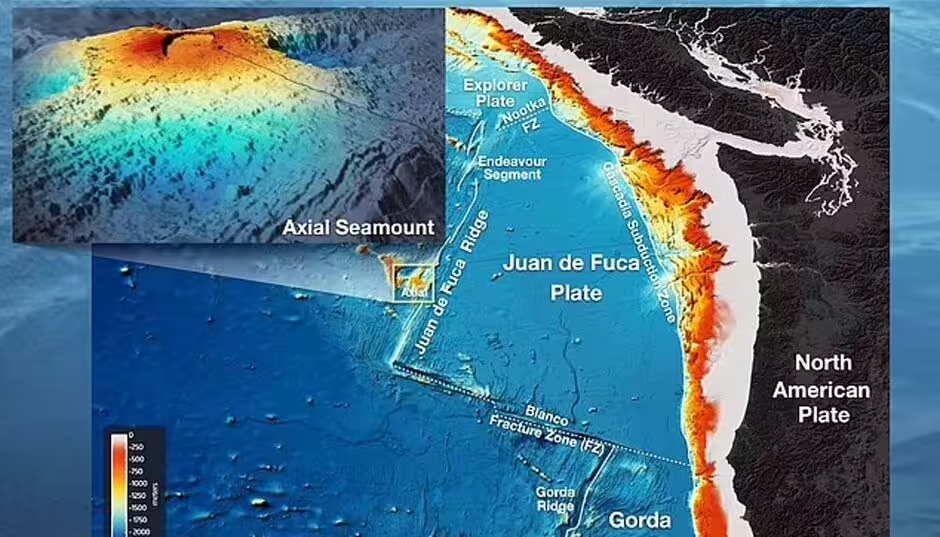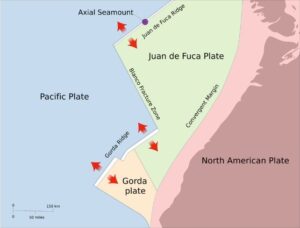
USGS is warning that three volcanoes could erupt in the coming hours, days or weeks, urging people that plan to be living or visiting around active volcanoes and active volcanic risk zones to be ready to take action should an eruption occur. The three volcanoes likely to erupt soon are Kilauea in Hawaii, Mount Spurr in Alaska, and the Axial Seamount located off the coast of Washington. Each volcano produces different hazards and USGS and local officials have advice for each.
Episode 14 of the ongoing Halemaʻumaʻu eruption at Kilauea’s summit ended at 1:49 pm local time on March 20 and the eruption is currently paused. However, USGS and the Hawaii Volcano Observatory (HVO) warns that the 15th eruptive episode likely to begin late today or tomorrow inside Hawaii Volcanoes National Park.

Kilauea’s current eruption in Halemaʻumaʻu crater within Kaluapele, the summit caldera, began on December 23, 2024. There have been 14 episodes of lava fountaining separated by pauses in activity. Current hazards include volcanic gas emissions and windblown volcanic glass, known in Hawaii as “Pele’s Hair”, may impact Hawai’i Volcanoes National Park and nearby communities. USGS and HVO will issue an update once the volcano erupts and the 15th event unfolds.
While Kilauea’s next eruption won’t occur near a populated area, the same isn’t true for another volcano that could erupt in the days ahead: Alaska’s Mount Spurr.
According to USGS and the Alaska Volcano Observatory (AVO), unrest continues at Mount Spurr volcano. Seismicity remains elevated with numerous small, shallow volcanic earthquakes detected beneath the volcano over the past day. No activity was observed in cloudy to partly cloudy satellite or webcam images.
AVO continues monitoring activity at Mount Spurr for signals indicating that the volcano is moving closer to an eruption. Based on previous eruptions, changes from current activity in the earthquakes, ground deformation, summit lake conditions, and fumarolic activity would be expected if magma began to move closer to the surface. Therefore, if an eruption occurred, it would be preceded by additional signals allowing warning. For now, the volcano is monitored using local seismic, infrasound, web camera, and GNSS stations along with regional infrasound, lightning networks and satellite data.
Volcano experts in Alaska are providing important updates and tips to prepare for the likelihood of a Mount Spurr eruption. This could have significant impacts to local communities & global aviation: https://t.co/H3YUoiiXKZ
— the Weatherboy (@theWeatherboy) March 24, 2025
Mount Spurr is a stratovolcano in the Aleutian Arc of Alaska, named after USGS geologist and explorer Josiah Edward Spurr, who led an expedition to the area in 1898. Known as the highest volcano of the Aleutian Arc, Spurr consists of a large stratocone constructed at the center of a roughly 3.1 mile wide horseshoe-shaped caldera that is open to the south. The volcano is about 80 miles west of Anchorage.
Mount Spurr is located in an area that could impact operations at Anchorage airport, the 4th busiest cargo airport in the world. More than 60,000 people travel over Alaska every day and an volcanic eruption here could have significant impacts to global aviation; ash associated with an eruption would force the closure of air space and airports.

The third volcano around the U.S. that USGS is monitoring a massive volcano located off the U.S. West Coast that they say can erupt at anytime. Known as the Axial Seamount, the under-water volcano is located about 300 miles off the coast of Washington. In recent months, scientists have seen the seamount dramatically increase in size and bulge, indicating that it is likely going to erupt soon. And while a significant eruption is likely, because of it’s location deep underwater, there are likely to be limited impacts, if any, to the U.S. West Coast. Beyond USGS, volcanologists and scientists around the U.S. are studying the volcano.
“Axial is the most active volcano in the Northeast Pacific which maybe some people don’t know, because it’s hidden under the ocean,” volcanologist Bill Chadwick told Jenn Chávezin in the Oregon Public Broadcasting podcast. Chadwick is a volcanologist with Oregon State University and has been documenting the changing shape and activity of the Axial Seamount for their College of Earth, Ocean, and Atmospheric Sciences.

Chadwick described the process the volcano evolves from periods of eruption to non-eruption back to eruption. “So, if it’s not erupting, it’s inflating and getting ready for the next one. And so that’s why we’re kind of monitoring what’s happening to it all the time.”
“The balloon keeps getting bigger and bigger. And at some point, the pressure becomes too great and the magma forces open a crack, flowing to the surface. When that happens, the seafloor subsides as the ‘balloon’ deflates,” Chadwick said.
The volcano can erupt a huge amount of lava, but its impacts won’t be too significant away from the ocean’s floor. The eventual eruption is unlikely to trigger a tsunami or earthquakes on land, but it would eject a huge volume of lava: in the volcano’s 2015 eruption, Axial spewed out 5.5 billion cubic feet of lava.
Mike Stone, a USGS researcher at Yellowstone Volcano Observatory, told Cowboy State Daily: “This particular volcano is probably the best-monitored submarine volcano in the world. It’s fascinating and doesn’t really pose a hazard. When Axial Seamount erupts, it’ll look a lot like a Hawaiian lava flow eruption,” Stone added. “It’s not an explosive eruption, but calm effusions of lava flowing out of the caldera and across the seafloor.”
It is not known when exactly the volcano will erupt, but based on how much the ground is swelling, it’s clear it’s moving into an eruptive phase rather than away from one.